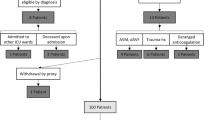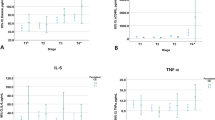Abstract
Background
High-mobility group box 1 protein (HMGB1) is a nuclear factor that is a potent proinflammatory mediator, and may trigger increases in other inflammatory cytokines. The inflammatory cytokines in the cerebrospinal fluid (CSF) of patients with subarachnoid hemorrhage (SAH) have been reported previously, but HMGB1 has not. In this study, we measured HMGB1 and the inflammatory cytokines in the CSF of patients with SAH.
Methods
CSF samples were collected on days 3, 7, and 14 from the drainage tubes of the postaneurysm clips of 39 patients with SAH. HMGB1, interleukin-6 (IL-6), IL-8, and tumor necrosis factor alpha (TNF-α) were measured in the CSF, and compared between the patients with favorable (good recovery and moderate disability) and unfavorable outcomes (severe disability, vegetative state, and death) at 3 months.
Results
In the unfavorable outcome group, HMGB1 (P = 0.017), IL-6 (P = 0.003), IL-8 (P = 0.041), and TNF-α (P = 0.002) were significantly increased. HMGB1 correlated significantly with IL-6, IL-8, and TNF-α (R = 0.672, 0.421, and 0.697, respectively).
Conclusions
HMGB1 was increased in the CSF of SAH patients with an unfavorable outcome, as were the other cytokines. These results suggest that HMGB1 and cytokines are related to the brain damage observed after SAH. HMGB1 might play a key role in the inflammatory response in the CNS of SAH patients.



Similar content being viewed by others
References
Anderson UG, Tracey KJ. HMGB1, a pro-inflammatory cytokine of clinical interest. J Intern Med. 2004;255:318–9.
Yan H, Wang H, Czura CJ, Tracey KJ. The cytokine activity of HMGB1. J Leukoc Biol. 2005;78:1–8.
Wang H, Bloom O, Zhang M, et al. HMG-1 as a late mediator of endotoxin lethality in mice. Science. 1999;285:248–51.
Mathiesen T, Andersson B, Loftenius A, et al. Increased interleukin-6 levels in cerebrospinal fluid following subarachnoid hemorrhage. J Neurosurg. 1993;78:562–7.
Kikuchi T, Okuda Y, Kaito N, et al. Cytokine production in cerebrospinal fluid after subarachnoid haemorrhage. Neurol Res. 1995;17:106–8.
Gaetani P, Tartara F, Pignatti P, et al. Cisternal CSF levels of cytokines after subarachnoid hemorrhage. Neurol Res. 1998;20:337–42.
Osuka K, Suzuki Y, Tanazawa T, et al. Interleukin-6 and development of vasospasm after subarachnoid haemorrhage. Acta Neurochir. 1998;140:943–51.
Hendryk S, Jarzab B, Josko J. Increase of the IL-1 beta and IL-6 levels in CSF in patients with vasospasm following aneurysmal SAH. Neuro Endocrinol Lett. 2004;25:141–7.
Takizawa T, Tada T, Kitazawa K, et al. Inflammatory cytokine cascade released by leukocytes in cerebrospinal fluid after subarachnoid hemorrhage. Neurol Res. 2001;23:724–30.
Oda Y, Tsuruta R, Kasaoka S, Inoue T, Maekawa T. The cutoff values of intrathecal interleukin 8 and 6 for predicting the neurological outcome in cardiac arrest victims. Resuscitation. 2009;80:189–93.
Wang H, Vishnubhakat JM, Bloom O, et al. Proinflammatory cytokines (tumor necrosis factor and interleukin 1) stimulate release of high mobility group protein-1 by pituicytes. Surgery. 1999;126:389–92.
Pullerits R, Jonsson IM, Kollias G, Tarkowski A. Induction of arthritis by high mobility group box chromosomal protein 1 is independent of tumour necrosis factor signaling. Arthritis Res Ther. 2008;10:R72.
Baumann H, Gauldie J. Acute phase response. Immunol Today. 1994;15:74–80.
Lennihan L, Mayer SA, Fink ME, et al. Effect of hypervolemic therapy on cerebral blood flow after subarachnoid hemorrhage, a randomized control trial. Stroke. 2000;31:383–91.
Yamada S, Inoue K, Yakabe K, Imaizumi H, Maruyama I. High mobility group protein 1 (HMGB1) quantified by ELISA with a monoclonal antibody that does not cross-react with HMGB2. Clin Chem. 2003;49:1535–7.
Morgan E, Varro R, Sepulveda H, et al. Cytometric bead array: a multiplexed assay platform with applications in various areas of biology. Clin Immunol. 2004;110:252–66.
Agnello D, Wang H, Yang H, Tracey KL, Ghezzi P. HMGB1, a DNA-binding protein with cytokine activity, induces brain TNF and IL-6 production, and mediates anorexia and taste aversion. Cytokine. 2002;18:231–6.
Harris HE, Anderson U. The nuclear protein HMGB1 as a proinflammatory mediator. Eur J Immunol. 2004;34:1503–12.
Takata K, Kitamura Y, Tsuchiya D, Kawasaki T, Taniguchi T, Shimohama S. High mobility group box protein-1 inhibits microglial Aβ clearance and enhances Aβ neurotoxicity. J Neurosci Res. 2004;78:880–91.
Andersson BU, Wang H, Palmblad K, et al. High mobility group 1 protein (HMG-1) stimulates proinflammatory cytokine synthesis in human monocytes. J Exp Med. 2000;192:565–70.
Randon-Mitchell BR, Ochiai M, Li J, et al. IFN-γ induces high mobility group box 1 protein release partly through a TNF-dependent mechanism. J Immunology. 2003;170:3890–7.
Kim JB, Choi JS, Yu YM, et al. HMGB1, a novel cytokine-like mediator linking acute neuronal death and delayed neuroinflammation in the postischemic brain. J Neurosci. 2006;26:6413–21.
Mathiesen T, Edner G, Ulfarsson E, Andersson B. Cerebrospinal fluid interleukin-1 receptor antagonist and tumor necrosis factor-α following subarachnoid hemorrhage. J Neurosurg. 1997;87:215–20.
Faraco G, Fossati S, Bianchi ME, et al. High mobility group box 1 protein is released by neural cells upon different stresses and worsens ischemic neurodegeneration in vitro and in vivo. J Neurochem. 2007;31:1–13.
Kimura H, Gules I, Meguro T, Zhang JH. Cytotoxicity of cytokines in cerebral microvascular endotherial cell. Brain Res. 2003;990:148–56.
Gong Q, Xu JF, Yin H, Liu SF, Duan LH, Bian ZL. Protective effect of antagonist of high-mobility group box 1 on lipopolysaccharide-induced acute lung injury in mice. Scand J Immunol. 2009;69:29–35.
Tang D, Kang R, Xiao W, et al. Quercetin prevents lipopolysaccharide-induced HMGB1 release and proinflammatory function. Am J Respir Cell Mol Biol 2009 (in press).
Acknowledgments
This clinical study was supported by a research project grant from the Japanese Ministry of Health, Labor, and Welfare (No. H18-trans-general-003). We are grateful to Kiyoshi Ichihara and Yuji Koyanagi (Department of Laboratory Science, Yamaguchi University Graduate School of Medicine) for their valuable statistical assistance, Taku Miyasho (Rakuno Gakuen University) and Hitomi Ikemoto (Yamaguchi University) for their valuable technical assistance with the measurements. We also thank Masako Ueda for assistance with the grant-related paperwork.
Conflict of interest statement
All work was conducted independently of the funding parties, except for a governmental grant. This grant had no influence on the decisions relating to the study design or publication.
Author information
Authors and Affiliations
Corresponding author
Rights and permissions
About this article
Cite this article
Nakahara, T., Tsuruta, R., Kaneko, T. et al. High-Mobility Group Box 1 Protein in CSF of Patients with Subarachnoid Hemorrhage. Neurocrit Care 11, 362–368 (2009). https://doi.org/10.1007/s12028-009-9276-y
Received:
Accepted:
Published:
Issue Date:
DOI: https://doi.org/10.1007/s12028-009-9276-y




